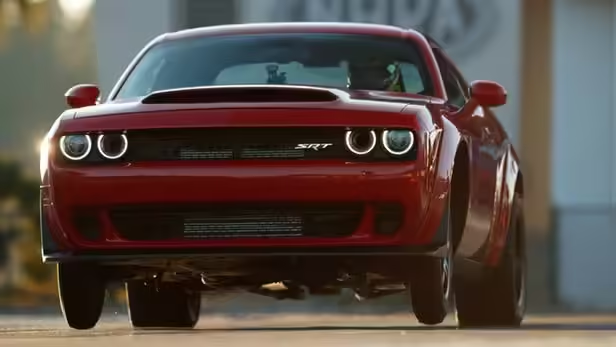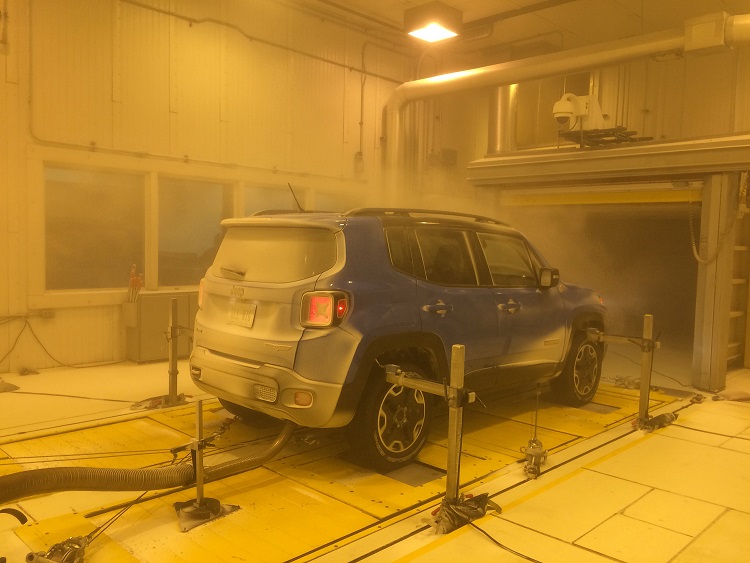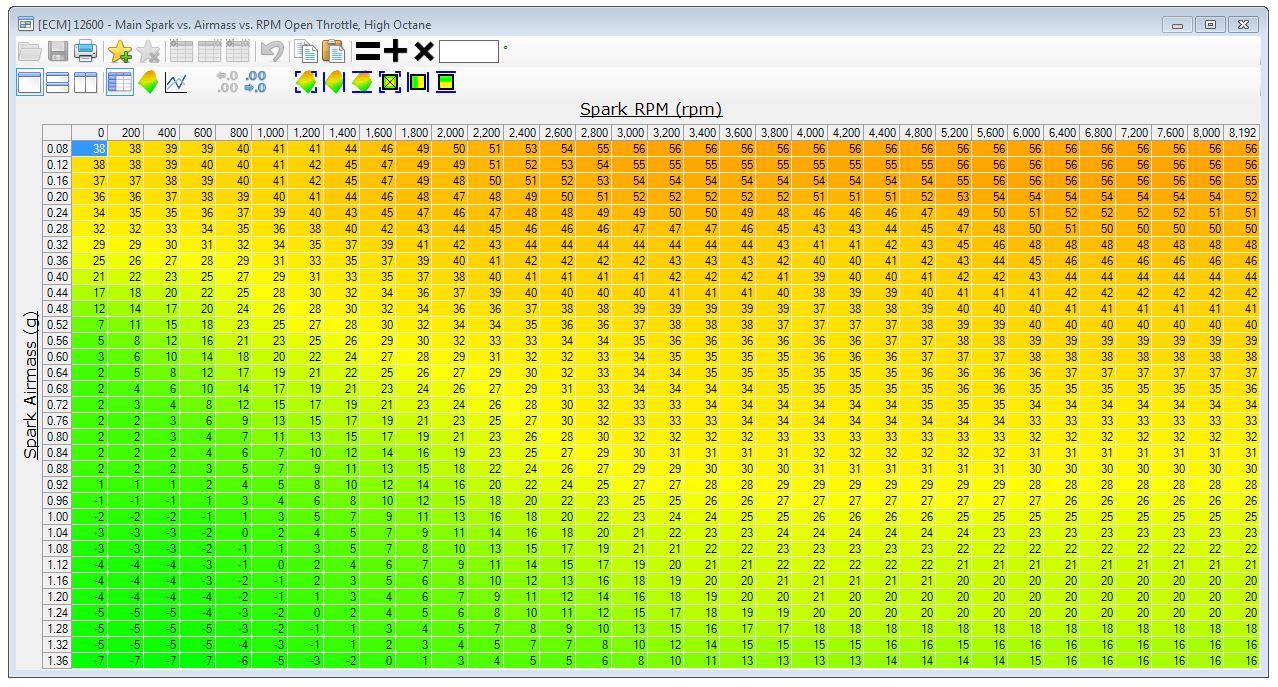
Dodge Demon factory fitted with an interchiller:
Dodge have seen the very large advantage of having colder intake temps, increased tuning scope and HP gains, as such their Dodge Demon and Hellcat Redeye both run a similar interchiller system to ours.
Why does my tuner want me to fit a chiller?
If the below examples you are about to read are understood, the answer to this question is simple. An interchiller will give you unlimited tuning scope.
Lets assume your turbocharged or supercharged engine has a water to air intercooler without a chiller.
Whilst tuning the car on the dyno on a 20c (68f) day, your intake air temps are swinging between 30c (86f) at the start of a power run and hitting a peak of 50c (122f). This is your tuning window that you are limited to, everything below 30c (86f) the tuner will be uncomfortable to add ignition timing simply because he doesn’t know how the engine is going to respond, too much timing and it could hurt the engine. For this reason the tuner will often zero out this area of the tune.
For everything above 50c (122f) the tuner understands he must start the removal of ignition timing, as the intake temps rise less timing can be run, how much timing to remove is the unknown factor here so the tuner guesses how much to remove, the tuner WILL or “should” play it safe and remove more timing than what is needed simply because they are unable to simulate that temperature zone and do not know how the engine will respond, so more timing will be removed than what is actually needed. This is fact there is no getting around this you cannot safely tune the engine without simulating all temperatures.
Caveman Tuners Rebuttal:

Said in a caveman voice; “I zero out my intake air temp table to 75c (167f) so you don’t pull any timing out” or “It gets as hot as it’s ever going to get on the dyno”
That’s fantastic but you could be adding more timing for colder temps from 0c (32f) up to 75c (167f) the fact that you think the engine will not respond to colder temps shows where the talent level is at. Why would OEM’s bother using temperature controlled dyno cells from freezing cold to desert hot if they could simply zero out their correction tables? and why do the factory tunes already have temperature corrections in the factory tune?
An interchiller gives you unlimited tuning scope
It’s every tuners dream to simulate as much as possible in a controlled environment like the dyno cell. With the interchiller fitted you are able to get intake temps as cold as possible says 0c (32f) but also turn the chiller off and heat it up to say 90c (194f) intake temps and every temperature in between as well.
Your tuner is then able to do power runs at all possible intake air temps between 0c (32f) and 90c (194f) they are also able to simulate any temperature, say 40c (104f) or 50c (122f) over and over again until that area is fine tuned running the exact correct amount of ignition timing, ALL GUESSWORK has been removed. You have a massive amount of repeatability here being able to repeat a power run with the exact same intake air temp over and over again until the tune is on target for both hot and cold intake temps. This is very similar to having an OEM temperature controlled dyno cell from arctic cold to desert hot.
You are no longer guessing how much timing to remove you are only removing the correct amount of timing. But better still when cold you are now adding the correct amount of additional timing you never had and making more HP.
Tuning of the intake temp tables only takes 30-45min but once you finish dyno tuning you literally know that whatever temperature the engine will see you are making as much HP as physically possible at any temperature, your tune is also very safe as all temps have been tuned to suit. Even an intercooler pump failure has been tuned to suit since you can take it to that point.
The HP gained from installing an interchiller on your engine comes from several factors; colder denser air, this air is more free flowing and under less pressure since it is denser, we often have customers say they lost 1-2psi of boost. The boost wasn’t lost the air is simply more dense and the pressure (measurement of restriction) is now less, this is a good thing and shows the chiller is working. Along with the colder denser air you have the ability to run more ignition timing.
Colder denser air even without additional timing will and does result in a HP gain but combined with additional timing even more power is gained. We have seen 10-15rwhp without any tune adjustments. Now with the ability to add more timing from the colder temps 40-45rwhp on a typical 20-25c (68-77f) day is what we usually see at a minimum on most platforms. With a higher retention of HP on hotter days or with heat soaked blowers, as example on a 36c (97f) day we have seen as high as 77rwhp gained, this is a true indication of how much HP is retained and gained versus a heat soaked blower in normal conditions… remember the dyno cell with a dyno fan is equivalent to a highway pull at 100km/h (60mph). You’ve probably seen at the track your intake temps are 30c (54f) above the ambient air temp…there is no dyno fan at the track. This is the point the chiller shines and the non interchiller cars get slower (they are no longer making the power they did on the dyno).
How do car manufacturers tune for temperature?
Car manufacturers do this exact same method of tuning, however with a temperature controlled dyno cell, they simulate arctic cold and desert like hot.
Fiat Chrysler Automobiles using a Four-Wheel-Drive Dyno For Cold Weather Testing
Brief explanation of ignition timing:
Ignition timing is a reference to the current piston position and crankshaft angle at the point where the spark plug fires in the combustion process. The need for advancing or retarding the timing of the spark is because fuel does not completely burn the instant the spark fires, the combustion gases take a period of time to expand. The angle is described as a certain angle advanced before top dead center (BTDC). Advancing the spark BTDC means that the spark is energized prior to the point where the combustion chamber reaches its minimum size when the piston reaches TDC.
You may often hear someone say at 16 degree’s of timing we made 600HP and at 18 degrees we picked up another 20HP a total of 620HP. In this case the spark is fired at 18 degrees BTDC improving engine efficiency and making more HP.
Engine Knock/Timing Retard:
In the above example it is a very simplified version of “lets add more timing and make more HP” unfortunately physics come into play and you can’t just keep adding ignition timing. Some limiting factors that determine how much ignition timing can be run are based around intake air temperature, combustion pressure/heat and engine RPM. (Some other factors we wont touch on in this article are, air fuel ratio, fuel type, spark plugs etc)
As intake air temps rise, the temperature and pressure in the combustion chamber increase, when fuel is injected and combined with the heat/pressure the ignition timing must be retarded (decreased) to be closer to TDC, to avoid a detonation, knock or pinging of the engine.
THIS IS ONLY AN EXAMPLE table from an LSA engine do not simply load this into an ECU

In the above example what you are seeing is ignition timing being added and removed vs intake air temperature.
We are going to focus this tech article on when you are at WOT for this we are going to be within the load cells of 1.12g to 1.36g
Now if we look to 1.36g vs 15c (59f) we can see that ignition timing has been advanced +4 degrees, this number of +4 is going to be added on top of your high octane spark table, lets view the high octane spark table below:
THIS IS AN EXAMPLE table from a stock LSA engine do not simply load this into an ECU

As can be seen in the high octane spark table the engine is referencing spark airmass in grams vs RPM.
Now lets look at 3200rpm at 1.36g, ignition timing here is 10 degrees. So the ignition of spark will take place at 10 degrees BTDC, in this particular case if we have an intake air temperature of 15c (59f) the IAT table is going to add +4 degrees of timing making the TOTAL timing 14 degrees BTDC.
Now lets look at the same cells again with an intake air temperature of 65c (149f) at 1.36g, we can see now that -3 degrees of timing has been removed so our total timing will drop from 10 degrees to 7 degree’s timing.
Now to keep this extremely simple lets assume that 1 degree additional timing is worth 10rwhp (in some cases this is quite accurate)
Lets look at this example in a HP term, lets assume at 3200rpm at 1.36g the engine is making 200hp, if we are then able to add +4 degrees of timing advance at 15c (59f) intake air temp we are able to increase this HP output to 240hp, if we remove -3 degrees of timing at 65c (149f) the HP level will drop to 170hp.
This is a perfect example of a drag racing situation after a burnout, when staging the car on the start line as the blower will heat soak if a chiller isn’t installed.
- If fitted with a chiller at 15c (59f) IAT2 you will have a HP level or 240HP
- If no chiller is fitted at 65c (149f) IAT2 you will have a HP level of 170HP
This above scenario will play out throughout your entire RPM range vs temperature.
Now you can see why having an interchiller is such a large advantage not only to tuning scope but being able to extract as much HP as physically possible from your engine, whilst also knowing your engine is very safe as you have had the ability to simulate and tune all possible scenarios in a controlled environment.
We have kept this explanation above as simple as possible so it’s easy to understand for non tuners out there, it’s being viewed and explained as a 2D (2 dimensional) map (spark air mass grams vs temperature) not to confuse people we have discussed only this aspect. However there is a 3rd map which makes the intake temp tuning 3D (3 dimensional) that is “IAT vs RPM”. We help tuners who install our kits to understand this and we even supply example data on exactly this showing them how to tune “Load vs IAT vs RPM” so they can extract every drop of HP at any temperature and at any temperature at any RPM point. As said you really do walk away from tuning knowing that you have extracted every drop of HP at ALL points within the tune, exactly like OEM tuning in a temperature controlled dyno cell.
Summary:
1. OEM’s using Interchillers
2. OEM’s Tuning with temperature controlled dyno cells
3. Corrections in your factory tune for temperature
4. Shown and proven how you are limited in tuning scope without controlling temperature
5. Showing how and why OEM’s tune for temperature to save your ass should something like an intercooler pump fail
(Please keep in mind the above ignition tables are from 2 different cars and are only being used as an example for this article to give you a reference on how they function with and without a chiller, please do not simply load these tables into an ECU)
